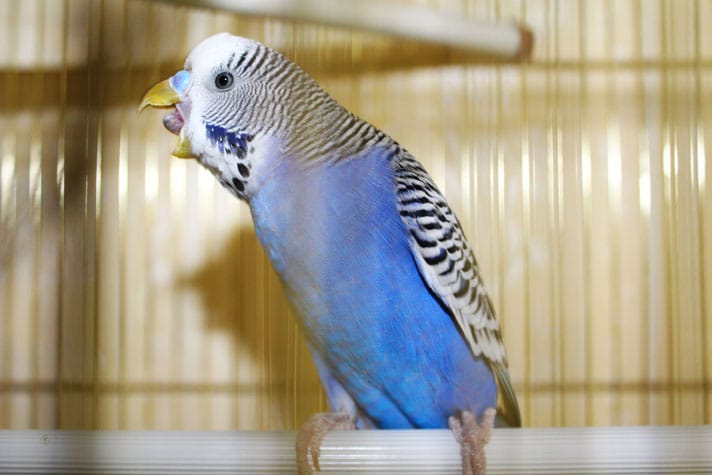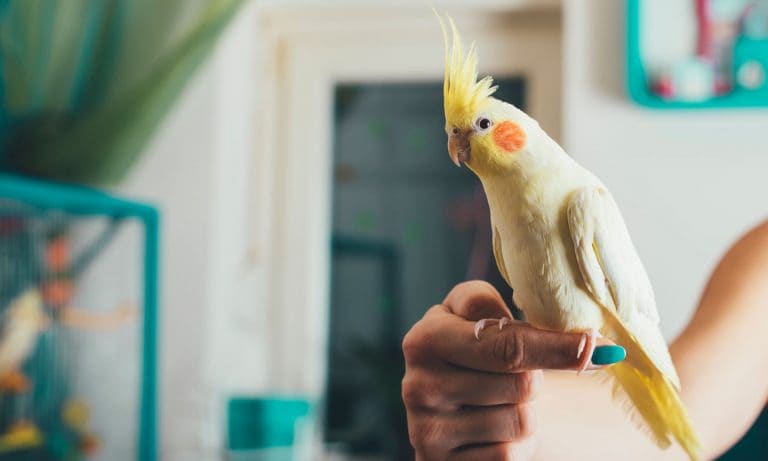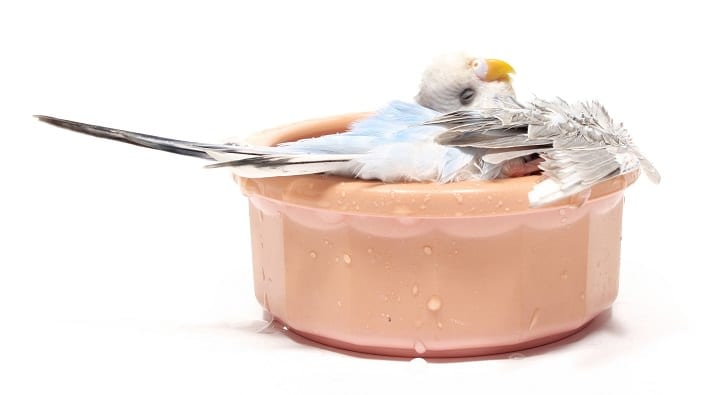Here we go again! The pet cockatoo is shrieking at the top of his seemingly bottomless lungs. The Senegal parrot is flapping and spinning like a maniac. The racket and the pet bird dust is unnerving on a normal day, but you have company coming in 15 minutes and the beginnings of a massive headache. There must be a way to calm your pet birds down, but how? Unfortunately, pet parrots don’t have off switches. (Not unlike children and spouses!) There may not be a quick fix to calming your pet bird but, with a little forethought and effort, you can teach your pet parrot to calm down quickly and encourage longer periods of quiet activity.
The best part is that molding a calmer pet bird is fun for both you and your parrot. It’s all about learning to read each other and have a “conversation”about your likes and dislikes. “A conversation?” you ask. Yes, bird training is really about learning to have a conversation with your pet bird. Your pet bird learns that when he whistles to you instead of screaming, plays quietly or lifts his foot when you say “Wave” that he gets a treat, a toy or your attention. You’ve explained your favorite things to him. In return your parrot may teach you to recognize when he wants to be left alone, when he is no longer interested in your newest game or when he really wants you to come over and give him a scratch and a cuddle. He’s given subtle cues about the language of feathers and hopefully you’ve listened.
Learning to read pet bird behavior, especially a bird’s body language, is a conversation, and you and your pet bird learn to read one another when you spend time conversing. Open, straightforward communication is the key to a peaceful and happy household, and this is true of all members of your family whether feathered, furred or teenagers with funky hairdos. So work on your communication skills with these 10 steps to a calmer pet bird.
1. Add Calm To The Chaos
To a certain degree all pet parrots are noisy and boisterous. We all have our moments, after all. If the chaos occurs frequently and regularly though, there’s a reason. The reason, my parrot-loving friend, is you! Every bird behavior that repeats itself has been rewarded somehow or it wouldn’t repeat. It’s possible that acting insane gets a pet parrot the attention he craves. If you throw a few almonds in the bowl to get him to hush or stop to chat and reason with your parrot when he’s pitching a fit, you’ve just had a very clear conversation with your pet bird. The conversation goes like this, “When you act crazy, you get a reward.” Likely the next time your parrot wants your attention or an extra treat, he’s going to raise a ruckus. Keep in mind that conversations require at least two individuals. You or someone else in the house has created this situation. The parrot didn’t do it alone. The good news is that now that you know this, you can work on having a different discussion with your pet parrot.
2. Read Your Pet Parrot’s Body Language
The single most important thing to get you on the path to success is learning to read your pet parrot’s body language. This is a good reason to spend a little bit of time training some simple behaviors, such as turning around or waving on cue. When you interact with your pet parrot in a learning situation, you learn to watch his eyes, feathers and body posture. You learn when your bird is distracted, about to fly off his perch, or even when he is about to bite you. Reading this subtle body language will help you recognize when your parrot is about to cause a ruckus and help you make a good guess at why. Calming down a pet parrot requires knowing if he is reacting to a situation or trying to get you to react. Sometimes calming down a pet parrot is as simple as moving that big scary box your husband left in the hallway. However, if you don’t recognize that your parrot is acting fearful, you won’t realize the box is bothering him.
3. Address Your Pet Bird’s Behavior, Not Emotion
We all know that parrots are thinking, feeling beings with plenty of their own emotions. Do you really know how your pet parrot is feeling and what he is thinking though? If you could read his mind, would you really be able to reason with him and explain why he should feel differently? Probably not. This doesn’t stop us from trying of course, but in the end, we have to get the parrot off the psychologist’s couch and look at what we can address: behavior. Maybe you think that your pet bird screams incessantly at the upper decibel range because he is angry with you. That may be, but it is much easier to address screaming than anger. Screaming is obvious. It starts for a recognizable reason, and it either gets rewarded somehow or it doesn’t. If you can figure out why your parrot screams, you can convince him to get what he wants a different way. Behavior can always be addressed. Emotions, even in people, often remain a mystery.
4. Make Your Pet Parrot’s Meals An Adventure
Busy parrots are quiet parrots and not only that, they are happy parrots. It’s true that some birds can eat and scream at the same time, but generally speaking birds that are thinking, exploring and playing are quiet and calm. So give your pet parrot a little more to do with his meals. Hide nuts and seed treats in small boxes, brown paper lunch bags and crumpled-up newspaper. Hang corncobs, broccoli and other vegetables that beg for destruction from metal kabobs designed for pet parrots or clip them around the cage. If your parrot makes “soup” then move the water bowl to the other side of the cage so that soup making is a journey. Put puzzle toys in the cage that require exploration and thought to dispense treats. If your parrot’s sole source of entertainment is trying to find ways to get you to interact with him, craziness may ensue. Make meal time a busy fun part of his day.
5. Provide Interesting Pet Bird Toys for Your Parrot
Don’t just stop with the meals. Make sure there are great pet bird toys in the cage. This doesn’t mean packing the cage so tight with 20 toys that your parrot can’t move. Instead, it requires a little effort and thought on your part. Set up an enrichment schedule so that every few days a toy gets rotated out. An old toy that your parrot hasn’t seen for a few weeks is like a new toy. Just a few pet bird toys that are always changing make a pet parrot’s home interesting and fun. Watch your parrot closely to make sure that he isn’t frightened of any of the pet bird toys before you put them in the cage, or they won’t be any fun to have around. Make sure the pet bird toys are safe as well. Other than that, the possibilities are limitless; try all different kinds of toys.
6. Reward Your Pet Bird’s Calm Behavior
Pay attention to when your pet bird is playing quietly, and reward these moments. Stop by the cage to give him a little bit of attention. Throw an extra pet bird treat in the bowl. Give him something to play with that is new and fun. This way you explain to your bird that you really like it when he’s peacefully playing. Perhaps if he wants your attention or an extra treat, he’ll try doing just that. Just like we can accidentally train screaming and other crazy pet bird behavior by rewarding it, we can intentionally train pet bird behaviors we really do like. Your parrot doesn’t know what to do to get your attention unless you tell him. Just be careful what you say!
7.Switch Up Your Pet Bird’s Schedule
Parrots can get noisy and boisterous in anticipation of something they want. It’s a great idea to feed your parrots twice a day and allow time for play outside of the cage, but sometimes the anticipation of these events can get a pet parrot going. If you let your bird out for playtime at exactly 7 pm every night, he might get wound up at 6:30 pm. Why not let him out at 5 pm sometimes? Or at 7:30 pm other times? Switch up your schedule a little if this seems to be something that gets your parrot going. Sometimes life is more fun when it’s not on a strict schedule.
8.Train A New Behavior With Your Pet Parrot
Don’t think of pet bird training as manipulation or demeaning. Think of it as focused one-on-one time. When you read a picture book to a child, you are trying to train that child to read. Still, that one-on-one time reading a book with Mom or Dad is adored! Your pet parrot will love the opportunity to spend some positive time with you as well. Attention and praise are appreciated by almost anyone, including your parrot. If you think your parrot is about to get wound up, spend a little training time with him. He can’t act up and focus on learning at the same time. If he’s already screaming and flapping, don’t reward this behavior of course, but if you can catch him before he gets going, you may be able to redirect his attention into something more fun and positive.
9. Cue An Incompatible Behavior In Your Pet Bird
If you’re going to spend some time training your parrot, why not teach him some things that he can’t do and act crazy at the same time? For example, if your Amazon parrot meows like a cat, teach him to meow when you ask, “What does a cat say?” He can’t scream and meow at the same time, and you may be able to redirect his attention into something quieter. If you cue your bird to wave, he can’t flap around and bang toys while waving at the same time. Give your bird something more constructive to do to get your attention or a treat, and you might eliminate some moments of craziness.
10. Allow Time For Parrot Chaos
Don’t forget that parrots will be parrots. You can’t expect perfect behavior all the time. There should be a time and a place for craziness. Some pet birds seem to love a grand session of loud vocalization and play at dawn and dusk. Some get going when you vacuum. They are all individuals. If it isn’t repetitive, incessant behavior, make an allowance for the occasional burst of chaos. Why not enjoy it and join in? Bursting into song and dance is good for everyone’s soul. Any one of these 10 steps can help your pet bird become a calmer member of the household. If you use all of these steps, you’ll have a happier parrot as well. If you’ve never trained a pet parrot before, pick up some books on parrot training, or attend a parrot-training workshop. Watch for events in your area. If you’re looking for ways to keep your parrots busy-beaked or want to know more about training, check out BeChewy for articles and community discussions. Above all else though, don’t forget the most important rule of sharing your life with a parrot. Have fun!
5 Easy Toys For Busy Pet Birds
- Empty cereal boxes with toys or treats hidden inside.
- Brown paper lunch bag with nuts and seeds hidden within.
- Tongue depressors for chewing and holding.
- Empty paper towel rolls with treats inside and the ends squished closed.
- Clean cardboard egg cartons with favorite treats hidden inside.
4 Fun Behaviors To Train With Your Pet Parrot
- Target: Touch a chopstick for praise or a treat.
- Wave: Lift a foot up on cue for praise or a treat.
- Turn around: Spin around in a circle on the perch for praise or a treat.
- Open wings: Lift wings on cue for a cuddle or treat.
Posted By: Chewy Editorial. Excerpt from BIRD TALK Magazine, March 2007 issue, with permission from its publisher, Lumina Media.
Featured Image: Via Alex_Schmidt/iStock/Thinkstock
Share:









